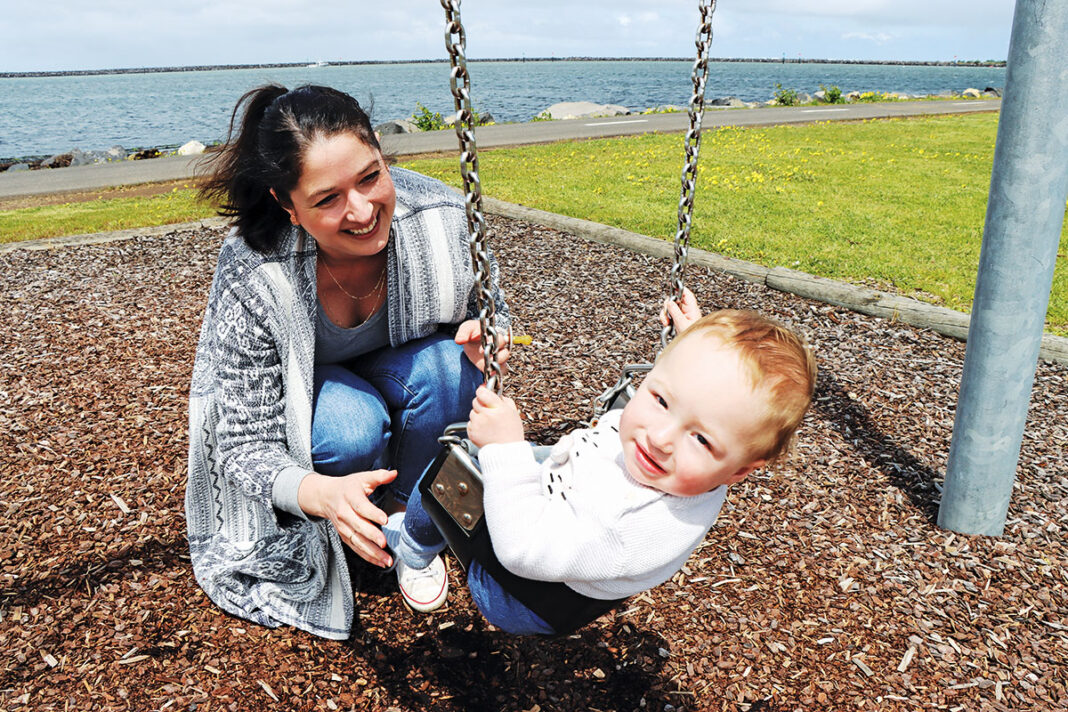Alocal mother is trying to address challenges surrounding childcare access by lobbying local MPs with a possible solution.
Tegan McPherson is suggesting the State Government adopt a model recently released in a research report by Regional Development Australia (RDA) Loddon Mallee.
The report summarises the problems and solutions for rural childcare and describes how cost-effective intervention would create a sustainable rural childcare model.
The situation is of personal interest to Ms McPherson who lives in Port MacDonnell and works in Mount Gambier.
She has been on waiting lists at three childcare centres in Mount Gambier for more than 12 months.
Ms McPherson started maternity leave in September last year to give birth to her son Caden.
Prior to maternity leave Ms McPherson worked in a full-time role for City Council.
In May this year she returned to work in a part-time capacity.
“I am grateful I have a flexible employer who is working with me while I wait for regular childcare,” she said.
“The work I’m doing is quite strategic for the community with council and that’s where I love to use my brain, and I’m not getting that full opportunity.”
Ms McPherson hopes to generate more community response on the issue.
In her letter to Mount Gambier MP Troy Bell and Federal Barker MP Tony Pasin, Ms McPherson highlighted the studies and projected childcare models that could benefit the region.
She said research conducted by the Mitchell Institute has indicated that 91.4% of the population of the Limestone Coast lives within a ‘childcare desert’.
“According to the latest Census data, there are just over 8500 children under the age of four that live in the Commonwealth Electoral Division of Barker,” she said.
“The region currently has 4.93 children per childcare place, ranking the second worst region in the state.
“I am one of many mothers who are experiencing challenges getting childcare so that I can return to work.
“My experience is not unique, and is certainly not representative of some who have been waiting much longer.”
Ms McPherson received responses from both Mr Bell and Mr Pasin, however felt neither addressed key elements of the report she had provided them.
She said there were a number of proposed interventions in the report “to improve effectiveness, viability and accessibility of early childhood education and care services in rural and regional areas”.
“They are, incentives for rural staff accreditation and retention through improved wages and conditions and financial incentive programs, providing assurance of service availability and reliability, increased rural Child Care Subsidy rate, and develop integrated early childhood facilities in priority rural locations,’ she said.
According to Ms McPherson, consideration would need to be given around who fills the void for the private market in South Australia.
“In Victoria, Local Government does this… a shared services model between councils is proposed in the report.
In addition, Ms McPherson said interventions will lift the uptake of services.
“As highlighted through consultation, the ideal solution is often the co-location of childcare centres with kindergartens and primary schools,” she said.
“This enables the joint resourcing of infrastructure, classroom materials, and educators, with major benefits generated as early childhood educators can transition across age groups and between long day care, kindergarten to afterschool care as needed.”
In response to Ms McPherson’s correspondence, Mr Bell said he agreed that workforce attraction and retention was a central issue for regional communities and the businesses and industries that operate within them.
“Unfortunately, childcare sits under the Federal Government and funding is derived from the Federal Government,” Mr Bell said.
“The State Government has announced a Royal Commission into Early Childhood Education.
“This will see three-year-olds accessing preschool education, which will also free up space in childcare centres for those children under the age of three.
“As you can see this issue is being taken very seriously by this State Government and the Federal Government.”
Mr Bell said there was no “quick fix” and attributed the current situation to “a decade of underinvestment”.
He said the challenge now was to get local centres that have capacity employing the staff to service the region’s childcare needs.
“In the longer term we also need to build the childcare centres for our future needs,” he said.
Mr Pasin also responded to Ms McPherson’s concerns, stating he had also experienced first-hand the issues with a staff member struggling to gain access to childcare when moving to the region.
“The need to increase access to childcare services across the Barker electorate is something that I have been advocating for both whilst the Coalition was in Government and now that we are in Opposition,” he said.
“In September this year I invited the Shadow Minister for Early Childhood Education to the region to hear firsthand from early learning providers and the education sector the challenges being faced around workforce shortages and the lack of available facilities.
“Rest assured I will continue to lobby the Labor Government to put in place appropriate policy mechanisms to improve the accessibility of childcare for parents in regional communities like Mount Gambier.”




